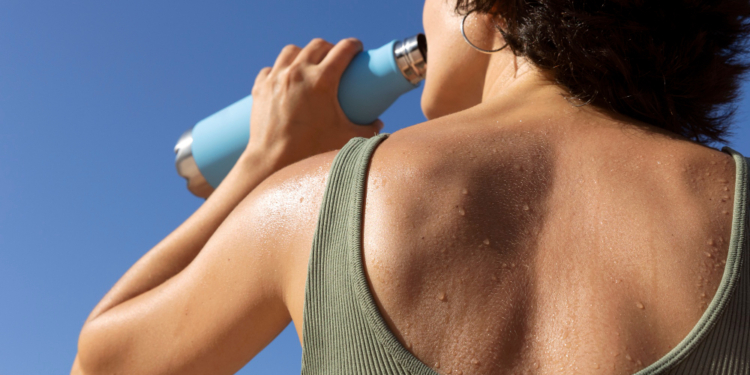The sun’s warm embrace may feel delightful on your skin, but it poses significant risks. Prolonged and unprotected exposure to the sun’s harmful UV rays can damage skin, including sunburn, premature ageing, and increased susceptibility to skin cancer.
To help you safeguard your skin from the sun’s potential harm, here are seven vital tips you should keep in mind:
How to protect your skin in the sun
1. Choose the Right Sunscreen
Sunscreen is a potent shield against the sun’s damaging effects. For individuals above six months of age, sunscreen is a must whenever you step outside. When selecting a sunscreen, it’s essential to choose the right type. According to the American Academy of Dermatology, opt for sunscreen that is:
– Broad-Spectrum
Look for a sunscreen that offers protection from both UVA (Ultraviolet A) and UVB (Ultraviolet B) rays.
– Sun Protection Factor (SPF) of 30 or Higher
Select a sunscreen with an SPF of at least 30. This ensures adequate protection against the sun’s harmful rays.
– Water-Resistant
While sunscreen can be labelled as “water-resistant,” it’s crucial to note that it is not entirely waterproof or sweatproof. Therefore, regular reapplication is essential, especially when swimming or sweating.
2. Proper Application and Reapplication
How you apply sunscreen greatly influences its effectiveness. To ensure optimal protection, apply sunscreen 15 to 30 minutes before sun exposure, allowing your skin to absorb it fully. After application, wait 10 to 20 minutes to avoid unintentionally rubbing off the sunscreen. To minimize the risk of sunburn, reapply sunscreen every two hours, or even sooner if you are swimming.
How Much Sunscreen Should You Apply?
Adhering to the “teaspoon rule” can help ensure you’re using an adequate amount of sunscreen to protect exposed skin. Here’s a breakdown of the rule:
- One teaspoon on your face and neck.
- One teaspoon on each arm.
- Two teaspoons on your front torso.
- Two teaspoons on your back.
- Two teaspoons on each leg.
3. Embrace Protective Clothing
Clothing is an effective way to reduce your UV exposure, but not all clothing provides the same level of protection. For maximum sun protection, consider the following factors when choosing your attire:
– Choose Thicker Fabrics
Opt for thicker fabrics like denim, which offer better protection than thinner materials like cotton.
– Darker Colors
Darker clothing shades provide more UV protection than lighter ones.
– Dry Fabrics
Wet fabrics can lose their UV protection capabilities, so choose dry clothing when possible.
Many clothing brands now offer comfortable, lightweight clothing to shield you from the sun’s harmful UV rays. Look for items with a UV protection factor (UPF) rating for added assurance, where a higher UPF number indicates superior UV protection.
4. Shield Your Head with a Wide-Brimmed Hat
Wearing a wide-brimmed hat with a brim of at least three inches in diameter effectively minimises sun exposure on your face. While baseball caps and other hats with narrower brims may provide some protection, they may leave areas like your ears, nose, and neck vulnerable.
5. Protect Your Eyes with Sunglasses
Sunglasses are not just a fashion statement; they are essential for safeguarding your eyes and the delicate skin around them from the sun’s harmful rays. The colour of the lenses is not indicative of their sun protection capabilities. Instead, choose sunglasses labeled as blocking 99% or 100% of UVA and UVB rays.
6. Avoid the Sun during Peak Hours
The sun’s UV rays are most potent between 10 a.m. and 4 p.m. Stay in the shade during these peak hours, or avoid extended outdoor exposure altogether.
7. Seek Shade Whenever Possible
One of the most effective ways to enjoy the outdoors while minimizing UV exposure is by staying in the shade. Whether you take refuge under a tree or set up a beach tent, finding shade is crucial, especially during the sun’s peak hours. This advice is particularly important for babies, who should avoid unnecessary sun exposure. For infants under six months old, always use strollers, hats, and umbrellas to shield them from the sun.
What to Do in Case of Sunburn
It can be quite uncomfortable if you find yourself with a mild to moderate sunburn. To ease the swelling and pain as your skin heals, consider using ibuprofen, aloe vera gel, or cold compresses. It’s crucial to refrain from picking any blisters. In case of blister rupture, clean the area with soap and water and cover it with a wet dressing to prevent infection.
In more severe cases, when sunburn results in vomiting, fever, or disorientation, seek medical attention at an urgent care centre.
Remember, you don’t need to confine yourself indoors, but taking precautions is essential to protect your skin and reduce the risk of skin cancer. Properly apply sunscreen, wear protective clothing, don hats and sunglasses, and seek shade when possible. Following these guidelines allows you to enjoy the outdoors while keeping your skin safe from the sun’s harmful effects.
FAQs
Here are some frequently asked questions regarding protecting your skin from sun damage:
Why is it important to protect your skin from sun damage?
Safeguarding your skin is crucial, as sun exposure can lead to sunburn, premature ageing, and an increased risk of skin cancer.
What are some effective ways to protect your skin from the sun?
Effective methods include applying sunscreen, seeking shade, wearing protective clothing, using sunglasses, exercising caution near reflective surfaces, and avoiding tanning beds.
How often should I apply sunscreen to protect my skin effectively?
To protect your skin effectively, apply sunscreen generously 15-30 minutes before sun exposure and reapply every two hours or more frequently if you’re swimming or sweating.
Can I still get enough vitamin D while protecting my skin from the sun?
Yes, you can maintain adequate vitamin D levels by getting brief sun exposure, consuming foods rich in vitamin D, and considering supplements after consulting your healthcare provider.









Discussion about this post